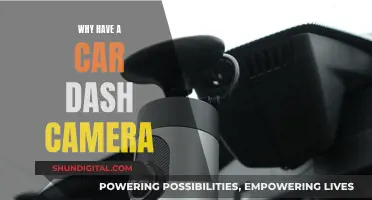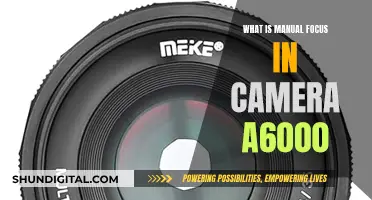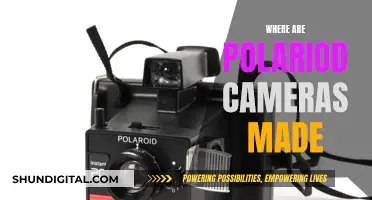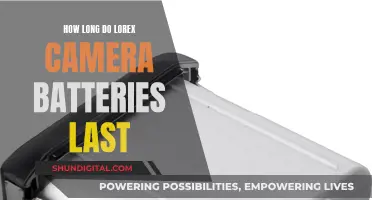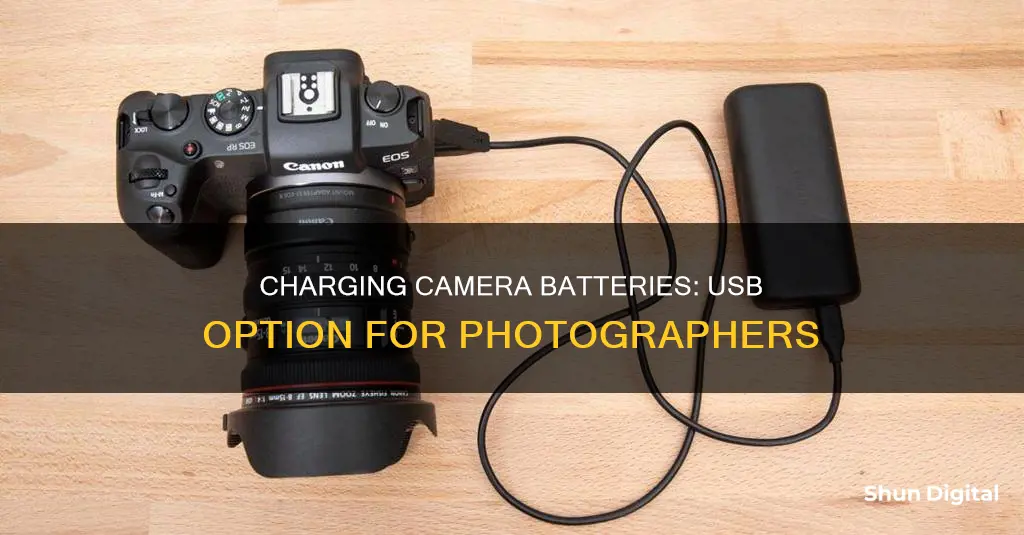
Charging a camera battery with a USB cable is a convenient option, especially when travelling. While some cameras can be charged directly via USB, others require a specific charger that accepts USB input. It's important to note that charging times may vary depending on the power source and the camera model. Some USB camera adapters may charge slower than standard wall chargers. Additionally, it's crucial to ensure that the USB cable has sufficient gauge and low resistance to allow for adequate power transfer during the charging process.
What You'll Learn

Charging a camera battery with a USB cable
To charge your camera battery using a USB cable, follow these steps:
First, check your camera's model number. This is important because different camera models have different battery types and charging requirements. You can usually find the model number on the battery itself or in the camera's manual.
Next, you'll need to obtain a compatible USB charger or cable. Some cameras come with a USB charging cable, while others may require you to purchase one separately. Ensure that the cable is compatible with your camera model.
Once you have the correct cable, insert the battery into your camera, following the instructions in your camera manual. Make sure the battery is inserted correctly and locked into place.
Now, connect the smaller end of the USB cable to the camera's charging port. The charging port is usually located near the battery compartment or on the side of the camera.
Finally, plug the other end of the USB cable into a power source. This can be a USB port on your computer, a power adapter, or an external battery pack.
It's important to note that some cameras may not charge properly if they are turned on during the charging process. Additionally, charging times may vary depending on the power output of the USB source. Always refer to your camera's manual for specific charging instructions and safety precautions.
By following these steps, you can conveniently charge your camera battery using a USB cable, ensuring that your camera is ready to capture all your important moments.
Kodak Camera Charging: How to Know It's Charging?
You may want to see also

Using a computer to charge a camera battery
Using a computer to charge your camera battery can be a convenient option, especially when you're on the go. However, it's important to note that not all cameras support USB charging, so always check your camera's manual or specifications before attempting this method. Here's a detailed guide on how to charge your camera battery using a computer:
Step 1: Check Compatibility
Before you begin, it's crucial to consult your camera's handbook or specifications to ensure that your camera supports USB charging. Some older camera models might not have this capability, and it's important to use the correct type of USB cable and adapter to ensure safe and efficient charging.
Step 2: Prepare the Camera
Make sure your camera is turned off. Some camera models require a memory card to be inserted for charging to work. Additionally, if your camera has a built-in USB cable, ensure you use that specific cable for charging. The USB jack on some cameras might not support charging.
Step 3: Insert the Battery
If your camera uses removable batteries, insert the battery into the camera for charging. Make sure the battery is facing the correct way and locks securely into place. Refer to your camera's manual for guidance on battery insertion if needed.
Step 4: Connect the USB Cable
With the smaller plug of the USB interface cable, connect it to the camera's terminal. Ensure it is fully inserted and oriented correctly as shown in your camera's manual. The USB cable should be high-quality to ensure effective and safe charging.
Step 5: Connect to the Computer
Now, take the larger plug of the USB interface cable and connect it to a USB terminal on your computer. A pop-up may appear on your computer screen, guiding you through the process of enabling charging through the port. Refer to your computer's manual for details about USB connections if needed.
Step 6: Monitor the Charging Process
Charging should begin automatically, and a USB charge lamp on your camera may light up to indicate this. Charging time can vary, but it typically takes around 2-3 hours for a compact lithium camera battery to fully charge. Once the charging is complete, the lamp will turn off. It's important not to leave the battery charging continuously for more than 24 hours to protect its optimal condition.
Additional Tips:
- Always use the original charging accessories provided by the camera manufacturer whenever possible.
- Keep the battery terminals and camera charging slot clean and dry.
- Avoid exposing the battery to excessive heat, low temperatures, strong magnetic fields, bright light sources, or lasers.
- Remove the battery from the camera or charger when not in use and cover the terminal.
- Store and transport the battery in its original box or a proper carrying case.
Charging Your Polaroid: A Step-by-Step Guide to Powering Up
You may want to see also

Charging a camera battery with a power adapter
First, check your camera model and battery type. Not all cameras support USB charging, so refer to your camera's handbook or specifications to confirm if it is compatible. Some older camera models might not support this charging method, and some batteries may require a specific type of USB camera battery charger. It is also important to use a high-quality USB cable, charger, and reliable power supply to ensure safe and efficient charging.
Once you have confirmed that your camera supports USB charging, gather the necessary equipment. This includes a USB power adapter, such as the USB Power Adapter PD-E1 for Canon cameras, and a compatible USB cable. Some cameras may require a USB charging converter, so be sure to check your camera's requirements.
Now, let's get into the step-by-step process:
- Turn off your camera. Most cameras cannot be charged while they are turned on, so this step is crucial.
- Connect the USB power adapter: With the camera power switch set to off, insert the USB power adapter plug fully into the digital terminal of your camera.
- Connect the power cord: Take the power cord and connect it to the USB power adapter. Then, plug the other end of the power cord into a power outlet.
- Begin charging: Once everything is connected, charging should start automatically. Depending on your camera model, you may see an access lamp lit in green to indicate that charging has begun.
- Wait for charging to complete: Keep the camera connected until the battery is fully charged. The access lamp turning off is usually an indication that charging is finished. However, refer to your camera's manual for specific details.
- Disconnect the power: Once the battery is fully charged, safely disconnect the power cord from the power outlet and the camera.
It is important to note that charging times may vary depending on factors such as ambient temperature and the remaining capacity of your battery. Always refer to your camera's manual for specific instructions and safety precautions related to charging. Additionally, avoid charging your battery continuously for more than 24 hours to maintain optimal battery health.
Charging Your SQ11 Camera: How Long Does It Take?
You may want to see also

Using a USB camera cradle to charge a camera battery
Step 1: Find Your Camera Battery Model Number
First, you need to identify the model number of your camera battery. Remove the battery from your digital camera and locate the model number, which is usually printed on the battery itself. This information is crucial for finding the right USB camera cradle.
Step 2: Find the Matching USB Camera Cradle
Once you have the model number, it's time to find the matching USB camera cradle. You can search for it online by entering the model number followed by "USB charger" or "USB cradle". Some websites allow you to search by brand or model number to find compatible cradles.
Step 3: Connect the Camera Cradle to a Power Source
Now that you have your camera cradle, it's time to connect it to a power source. You can use a USB battery pack, a laptop, an AC adapter, or even an external battery. If you're using a USB battery pack, look for one that is optimised for charging camera batteries, like those with higher amp output for faster charging.
Step 4: Place the Battery in the Cradle
Place your camera battery into the USB camera cradle, ensuring that the metal terminals of the battery and the cradle make proper contact. Some cradles can charge multiple batteries simultaneously, so you can charge any spare batteries you have along with the depleted one.
Step 5: Monitor Charging Progress
Depending on your USB camera cradle, there may be LED lights or other indicators to show you the charging progress. Some cradles may also have safety features that turn off the charging process once the battery is fully charged.
Additional Considerations:
- Always refer to your camera's user manual to ensure that your camera supports USB charging.
- Be cautious when using third-party USB camera cradles, as they may not be endorsed by the camera manufacturer.
- Keep in mind that charging times may vary depending on the input requirements of the battery, output capabilities of the cradle, and the power source used.
- To protect your battery and maintain its optimal condition, avoid continuously charging it for more than 24 hours.
- If you're using a power adapter, ensure it is compatible with the power outlet you intend to use.
By following these steps and considerations, you can confidently use a USB camera cradle to charge your camera battery, especially when you're on the go and don't have access to a standard power outlet.
Rechargeable Camera Batteries: Charged or Not When Bought?
You may want to see also

Charging a camera battery with a power bank
Step 1: Check Compatibility
First, you need to check if your camera supports USB charging. Consult your camera's handbook or specifications to confirm if it can be charged via USB and what type of cable or adapter is required. Some older camera models might not support USB charging, and some batteries may need a particular type of USB camera battery charger.
Step 2: Get the Right Equipment
If your camera is compatible with USB charging, you'll need the following:
- A power bank: Ensure it's powerful enough to charge your camera. Power banks for high-power video cameras tend to be larger.
- USB cable: Use a high-quality USB cable to ensure secure and effective charging. The cable should be compatible with your camera's USB port.
Step 3: Connect the Camera to the Power Bank
Now, you can connect your camera to the power bank:
- Place the battery into the camera: Ensure it is facing the right way and locks into position.
- Connect the USB cable: Plug the USB cable into your camera's USB port. The port is usually covered by a small flap.
- Plug the other end of the USB cable into the power bank: Ensure the power bank is turned on or will turn on automatically when a device is connected.
Step 4: Monitor the Charging Process
Once everything is connected, your camera battery will start charging. The charging time will depend on the power output of the power bank and the camera battery's charging speed. Some cameras may not be usable while charging, so plan your charging time accordingly.
Additional Tips:
- Charging speed: USB charging is generally slower than using a dedicated charger, so keep that in mind if you need a quick charge.
- Battery voltage: Camera batteries usually have a higher voltage than USB ports. The camera adapter boosts the voltage to enable charging.
- Battery maintenance: Avoid continuously charging your camera battery for more than 24 hours to protect its health and keep it in optimal condition.
- Alternative options: If you're having trouble finding a suitable USB charging setup, consider a V-mount battery, which offers high power, compact size, and multiple ports for different devices.
By following these steps and tips, you should be able to successfully charge your camera battery using a power bank.
Dash Cam Power: Staying Charged and Ready
You may want to see also
Frequently asked questions
Yes, you can. Many cameras can be charged via USB, either directly in the camera itself or with a charger that accepts USB input. Smaller cameras, like GoPros, often come with USB chargers by default.
First, you need to find your camera battery model number. Then, find the matching USB camera cradle. Finally, connect the camera cradle to a battery pack or solar panel.
Charging your camera battery with a USB cable is far more convenient when travelling, as you don't need to take a dedicated charger for each device and type of battery.



